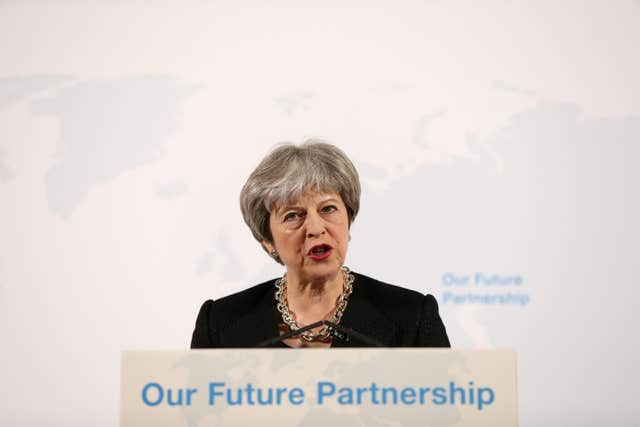
THERESA MAY has set out details of her vision for a future economic relationship with the European Union which she believes can deliver “an optimistic and confident future which can unite us all” leaving Britain “a stronger and more cohesive nation”.
In a high-profile speech at London’s Mansion House, the Prime Minister set out five “foundations” to underpin the new relationship – including binding commitments to fair competition and a new arbitration mechanism to resolve disputes.
She repeated her “red lines” that the UK will leave the single market and customs union and the jurisdiction of the European Court of Justice, but she also spelt out greater details on the customs arrangements Britain wants to avoid a hard border on the island of Ireland.
Declaring that she was “confident” that a deal is “achievable”, Mrs May said her message to Brussels was: “We know what we want. We understand your principles. We have a shared interest in getting this right. Let’s get on with it.”
She vowed that she would not walk away from talks over the coming months. But in response to questions, she made clear that she stands by her mantra that “no deal is better than a bad deal”.
Mrs May acknowledged that neither side would get “exactly what we want” from Brexit negotiations, and that access to each other’s markets will be reduced after UK withdrawal.
The Prime Minister challenged the European Commission’s insistence that “cherry-picking” of EU rights and obligations cannot be allowed.
Setting out her desire for a deal “tailored to the needs of our economies”, Mrs May insisted that all free trade agreements offer varying market access depending on the interests of the countries involved.
Nicola Sturgeon responds to Theresa May speech, saying Hard Brexit plan is ‘bizarre’
“If this is cherry-picking, then every trade arrangement is cherry-picking,” she said. “What would be cherry-picking would be if we were to seek a deal where our rights and obligations were not held in balance. And I have been categorically clear that is not what we are going to do.”
And she added: “What is clear is that for us both to meet our objectives we need to look beyond the precedents, and find a new balance.”
Mrs May said that any deal on the future UK/EU partnership must pass the “five tests” of respecting the result of the 2016 referendum; delivering an enduring solution; protecting security and prosperity; leaving Britain as an “open, outward-looking, tolerant, European democracy; and strengthening the union of the UK.
And she said the agreement should rest on “five foundations”:
– Reciprocal binding commitments to ensure fair and open competition;
– A completely independent arbitration mechanism to resolve disputes;
– An ongoing dialogue with the EU, with regular consultation;
– An arrangement for data protection; and
– Measures to maintain links between people.
Mrs May said: “The world is watching.
“We should not think of our leaving the EU as marking an ending, as much as a new beginning for the United Kingdom and our relationship with our European allies.
“Change is not to be feared, so long as we face it with a clear-sighted determination to act for the common good.
“Nor is Brexit an end in itself. Rather, it must be the means by which we reaffirm Britain’s place in the world and renew the ties that bind us here at home.
“And I know that the United Kingdom I treasure can emerge from this process a stronger, more cohesive nation.
“This is an optimistic and confident future which can unite us all.”
Looking ahead to the talks due to begin at the European Council summit on March 22 and lead to broad agreement on the future relationship by October, Mrs May said: “Yes, there will be ups and downs over the months ahead.
“As in any negotiation, no-one will get everything they want.
“We will not be buffeted by the demands to talk tough or threaten a walk out. Just as we will not accept the counsels of despair that this simply cannot be done.
“We will move forward by calm, patient discussion of each other’s positions. It is my responsibility as Prime Minister to provide that leadership for our country at this crucial time.
“By following the course I have set out today, I am confident we will get there and deliver the right outcome for Britain and the EU.”

Enjoy the convenience of having The Sunday Post delivered as a digital ePaper straight to your smartphone, tablet or computer.
Subscribe for only £5.49 a month and enjoy all the benefits of the printed paper as a digital replica.
Subscribe